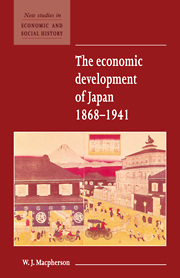Book contents
- Frontmatter
- Contents
- List of tables
- Notes on references
- Preface
- 1 Introduction
- 2 Growth and structural change
- 3 The Tokugawa background (c. 1600–1860)
- 4 The role of the state
- 5 Factors in demand
- 6 Land and agriculture
- 7 Labour supply and the labour market
- 8 Capital, technology and enterprise
- 9 Conclusion
- Bibliography
- Bibliographical update
- Updated bibliography
- Index
- New Studies in Economic and Social History
7 - Labour supply and the labour market
Published online by Cambridge University Press: 11 January 2010
- Frontmatter
- Contents
- List of tables
- Notes on references
- Preface
- 1 Introduction
- 2 Growth and structural change
- 3 The Tokugawa background (c. 1600–1860)
- 4 The role of the state
- 5 Factors in demand
- 6 Land and agriculture
- 7 Labour supply and the labour market
- 8 Capital, technology and enterprise
- 9 Conclusion
- Bibliography
- Bibliographical update
- Updated bibliography
- Index
- New Studies in Economic and Social History
Summary
‘Labour is the chief industrial asset of Japan. With few resources in power and raw materials, a limited supply of capital and no especial distinction in mechanical skill. Japan has built an industrial system upon cheap labour.’ So wrote John Orchard in 1930. Yet the emergence of a modern industrial labour force was beset with problems of recruitment, training, supply bottlenecks and inadequate managerial skills. Dorothy Orchard could write in 1929 that ‘labour in Japan has neither been very abundant nor very cheap for industrial purposes’. In early Meiji, ruthless exploitation, long working hours and primitive conditions are described. Female cotton and silk workers suffered low wages, a poor environment in factory and dormitory and unusually high turn-over rates. There were acute labour shortages, fierce competitive employer recruiting, sweatshops and suppression of labour movements. Over time, the dilemmas of employers and the hardships of workers were eased. The average worker in the 1930s was said to be three times better off than in the 1860s, and Patrick thought that ‘the material conditions of virtually all Japanese improved between early Meiji years and the mid- 1930s’.
Labour supply is a function of changes in the participation rate, in immigration and in rates of natural increase of population. The pre-Second World War category of ‘gainfully occupied workers’ included self-employed and family workers as well as some unemployed. Until about 1925 the rate of growth of gainful workers at about 0.5 per cent per annum was smaller than that of population, implying a falling participation rate due, mainly, to the spread of compulsory education.
- Type
- Chapter
- Information
- The Economic Development of Japan 1868–1941 , pp. 56 - 63Publisher: Cambridge University PressPrint publication year: 1995



